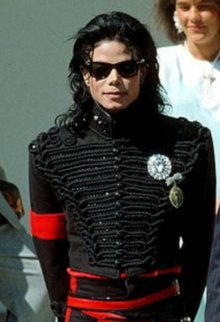Portal:Television
In today's world, Portal:Television has acquired unexpected relevance. Its impact has been felt in every area of society, from politics to culture, technology and the economy. It is impossible to ignore its presence, since its effects can be seen in the daily lives of millions of people around the world. Therefore, it is imperative to delve into its implications and understand the role it plays today. This article aims to explore the different facets of Portal:Television, analyzing its influence and its repercussions in different areas, in order to shed light on a phenomenon that is constantly evolving.
Portal maintenance status: (July 2018)
|
The Television Portal

Television (TV) is a telecommunication medium for transmitting moving images and sound. Additionally, the term can refer to a physical television set, rather than the medium of transmission. Television is a mass medium for advertising, entertainment, news, and sports. The medium is capable of more than "radio broadcasting", which refers to an audio signal sent to radio receivers.
Television became available in crude experimental forms in the 1920s, but only after several years of further development was the new technology marketed to consumers. After World War II, an improved form of black-and-white television broadcasting became popular in the United Kingdom and the United States, and television sets became commonplace in homes, businesses, and institutions. During the 1950s, television was the primary medium for influencing public opinion. In the mid-1960s, color broadcasting was introduced in the U.S. and most other developed countries.
In 2013, 79% of the world's households owned a television set. The replacement of earlier cathode-ray tube (CRT) screen displays with compact, energy-efficient, flat-panel alternative technologies such as LCDs (both fluorescent-backlit and LED), OLED displays, and plasma displays was a hardware revolution that began with computer monitors in the late 1990s. Most television sets sold in the 2000s were flat-panel, mainly LEDs. Major manufacturers announced the discontinuation of CRT, Digital Light Processing (DLP), plasma, and even fluorescent-backlit LCDs by the mid-2010s. LEDs are being gradually replaced by OLEDs. Also, major manufacturers have started increasingly producing smart TVs in the mid-2010s. Smart TVs with integrated Internet and Web 2.0 functions became the dominant form of television by the late 2010s. (Full article...)
Selected article - show another
"Favorite Son" is an episode of the American science fiction television series Star Trek: Voyager. First broadcast on UPN on March 19, 1997, it was the 20th episode of the third season. Lisa Klink wrote and Marvin V. Rush directed the episode. Set in the 24th century, the show follows the adventures of the crew of the starship USS Voyager after they are stranded in the Delta Quadrant, far from the rest of the Federation.
In the episode, Ensign Harry Kim (Garrett Wang) experiences déjà vu and develops a rash when the Voyager enters a new sector of the Delta Quadrant. Mostly female aliens known as Taresians tell him that he is not human but is a member of their species. On discovering this is a ruse by the female aliens to attract and kill their men during reproduction, the crew rescues Kim and restores him to his original state. Deborah May and Kristanna Loken play two of the Taresians, Patrick Fabian portrays a man tricked by them and Irene Tsu appears as Kim's mother.
Selected image - show another

| Credit: Caroline Culler |
A newscast typically consists of the coverage of various news events and other information, either produced locally in a radio or television station newsroom, or by a broadcast network. It may also include such additional material as sports coverage, weather forecasts, traffic reports, commentary and other material that the broadcaster feels is relevant to their audience.
Did you know (auto-generated) - load new batch

- ... that a federal marshal seized a car and a truck because there was no other way to satisfy a debt owed by Arkansas television station KRZB-TV?
- ... that the television series The Owl's Legacy was modelled after the ancient Greek symposium?
- ... that John Seigenthaler hosted a literary interview program which ran for 42 years on Nashville Public Television?
- ... that a Nebraska TV station stopped carrying live studio wrestling after wrestlers kicked a TV monitor?
- ... that ethnic broadcasting pioneer Shushma Datt was the first Canadian woman to obtain a CRTC broadcast licence?
- ... that Mike Gorman spent 43 consecutive years as the television play-by-play commentator for the Boston Celtics?
Selected quote - show another
| What the mass media offer is not popular art, but entertainment which is intended to be consumed like food, forgotten, and replaced by a new dish. |
More did you know
- ...that the book The Psychology of The Simpsons uses this TV series to analyze topics in psychology including clinical psychology, cognition and Pavlovian conditioning?
- ...that Molly Badham, co-founder of Twycross Zoo, trained the chimpanzees who appeared in the long-running Brooke Bond PG Tips television advertisements?
- ...that an advertising spot immediately following Xinwen Lianbo, a daily news programme shown by most terrestrial television stations in mainland China, can sell for an estimated US$100,000?
- ...that the color signals of Israel Broadcasting Authority television transmissions were erased until 1981, to insure equality for families who couldn't afford color-tv?
- ...that the Zambian district of Chiengi has no television or telephone service?
Selected biography - show another
Sydney Cecil Newman OC (April 1, 1917 – October 30, 1997) was a Canadian film and television producer, who played a pioneering role in British television drama from the late 1950s to the late 1960s. After his return to Canada in 1970, Newman was appointed acting director of the Broadcast Programs Branch for the Canadian Radio and Television Commission (CRTC) and then head of the National Film Board of Canada (NFB). He also occupied senior positions at the Canadian Film Development Corporation and Canadian Broadcasting Corporation, and acted as an advisor to the Secretary of State.
During his time in Britain in the 1950s and 1960s, he worked first with ABC Weekend TV, before moving across to the BBC in 1962, holding the role of Head of Drama with both organisations. During this phase of his career, he created the spy-fi series The Avengers and co-created the science-fiction series Doctor Who, as well as overseeing the production of groundbreaking social realist drama series such as Armchair Theatre and The Wednesday Play. (Full article...)General images
-
Image 1The first mass-produced Czechoslovak TV-set Tesla 4001A (1953–57) (from History of television)
-
Image 4The Nipkow disk. This schematic shows the circular paths traced by the holes, which may also be square for greater precision. The area of the disk outlined in black shows the region scanned. (from History of television)
-
Image 6LG Smart TV using the Web browser (from Smart TV)
-
Image 7Smart TVs on display (from Smart TV)
-
Image 8Baird in 1925 with his televisor equipment and dummies "James" and "Stooky Bill" (right) (from History of television)
-
Image 9Philo Farnsworth in 1924 (from History of television)
-
Image 10An early Smart TV from 2012 running the discontinued Orsay platform (from History of television)
-
Image 11Ad for the beginning of experimental television broadcasting in New York City by RCA in 1939 (from History of television)
-
Image 12First television test broadcast transmitted by the NHK Broadcasting Technology Research Institute in May 1939 (from History of television)
-
Image 13Color bars used in a test pattern, sometimes used when no program material is available (from History of television)
-
Image 14Samsung's discontinued Orsay platform (from Smart TV)
-
Image 15Family watching TV, 1958 (from History of television)
-
Image 16RCA 630-TS, the first mass-produced television set, which sold in 1946–1947 (from History of television)
-
Image 17This live image of actress Paddy Naismith was used to demonstrate Telechrome, John Logie Baird's first all-electronic color television system, which used two projection CRTs. The two-color image would be similar to the basic Telechrome system. (from Color television)
-
Image 18Comparison of image quality between ISDB-T (1080i broadcast, top) and NTSC (480i transmission, bottom) (from Digital television)
-
Image 19A color television test at the Mount Kaukau transmitter site, New Zealand in 1970.
A test pattern with color bars is used to calibrate the signal. (from Color television) -
Image 20LG Electronics smart TV from 2011 (from Smart TV)
-
Image 21DBS satellite dishes (from History of television)
-
Image 22The Philco Predicta, 1958. In the collection of The Children's Museum of Indianapolis (from History of television)
-
Image 23RCA CT-100 at the SPARK Museum of Electrical Invention playing Superman. The RCA CT-100 was the first mass-produced color TV set. (from Color television)
 Featured lists - load new batch
Featured lists - load new batch
-
Image 1

Community is an American television sitcom created by Dan Harmon. The show ran for six seasons and 110 episodes, with its first five seasons airing on NBC from September 17, 2009, to April 17, 2014 and the final season airing on Yahoo! Screen from March 17 to June 2, 2015. Set at Greendale Community College, the series stars an ensemble cast playing members of a diverse study group. The main cast includes Joel McHale as Jeff Winger, Gillian Jacobs as Britta Perry, Danny Pudi as Abed Nadir, Yvette Nicole Brown as Shirley Bennett, Alison Brie as Annie Edison, Donald Glover as Troy Barnes, Ken Jeong as Ben Chang, Chevy Chase as Pierce Hawthorne, and Jim Rash as Dean Craig Pelton. A comedy about friendships and relationships, the show uses frequent pop culture references and meta-humor, as well as high-concept episodes including documentary spoofs, action movie homages and storylines inspired by movies.
Despite being critically acclaimed and gaining a cult following, the show faced production issues and repeatedly came close to cancellation. The third season was subject to a mid-season replacement, its second half airing months later than originally planned. Harmon was fired as showrunner for the fourth season, though he was rehired by the fifth season. The end of the fourth season and middle of the fifth season saw the departures of Chase and Glover, respectively. The show was cancelled by NBC and moved to Yahoo! Screen for its sixth and final season, which also saw the departure of Brown. Community was effectively cancelled when Yahoo! Screen shut down in 2016. (Full article...) -
Image 2(Full article...)
Series Episodes Originally released First released Last released Network 1 3 4 December 2011 (2011-12-04) 18 December 2011 (2011-12-18) Channel 4 2 3 11 February 2013 (2013-02-11) 25 February 2013 (2013-02-25) Special 16 December 2014 (2014-12-16) 3 6 21 October 2016 (2016-10-21) Netflix 4 6 29 December 2017 (2017-12-29) Interactive film 28 December 2018 (2018-12-28) 5 3 5 June 2019 (2019-06-05) 6 5 15 June 2023 (2023-06-15) -
Image 3(Full article...)
Season Episodes Originally aired Rank Rating First aired Last aired 1 9 March 27, 2005 (2005-03-27) May 22, 2005 (2005-05-22) 8 11.6 2 27 September 25, 2005 (2005-09-25) May 15, 2006 (2006-05-15) 5 12.5 3 25 September 21, 2006 (2006-09-21) May 17, 2007 (2007-05-17) 7 12.1 4 17 September 27, 2007 (2007-09-27) May 22, 2008 (2008-05-22) 9 10.4 5 24 September 25, 2008 (2008-09-25) May 14, 2009 (2009-05-14) 10 9.6 6 24 September 24, 2009 (2009-09-24) May 20, 2010 (2010-05-20) 11 9.0 7 22 September 23, 2010 (2010-09-23) May 19, 2011 (2011-05-19) 17 7.5 8 24 September 22, 2011 (2011-09-22) May 17, 2012 (2012-05-17) 21 7.6 9 24 September 27, 2012 (2012-09-27) May 16, 2013 (2013-05-16) 18 7.7 10 24 September 26, 2013 (2013-09-26) May 15, 2014 (2014-05-15) 11 8.5 11 25 September 25, 2014 (2014-09-25) May 14, 2015 (2015-05-14) 17 7.8 12 24 September 24, 2015 (2015-09-24) May 19, 2016 (2016-05-19) 11 7.9 13 24 September 22, 2016 (2016-09-22) May 18, 2017 (2017-05-18) 16 7.3 14 24 September 28, 2017 (2017-09-28) May 17, 2018 (2018-05-17) 12 7.1 15 25 September 27, 2018 (2018-09-27) May 16, 2019 (2019-05-16) 20 6.5 16 21 September 26, 2019 (2019-09-26) April 9, 2020 (2020-04-09) 30 7.0 17 17 November 12, 2020 (2020-11-12) June 3, 2021 (2021-06-03) 36 7.6 18 20 September 30, 2021 (2021-09-30) May 26, 2022 (2022-05-26) 34 6.4 19 20 October 6, 2022 (2022-10-06) May 18, 2023 (2023-05-18) 42 5.2 20 10 March 14, 2024 (2024-03-14) May 30, 2024 (2024-05-30) 42 5.1 -
Image 4

Dexter is an American television drama that was broadcast on the premium cable channel Showtime from October 1, 2006, to September 22, 2013. A total of 96 episodes of Dexter were broadcast over eight seasons.
The series is based on characters created by Jeff Lindsay for his "Dexter" series of novels, and follows the life of Dexter Morgan (Michael C. Hall), a Miami Metro Police Department blood pattern analyst with a double life. While investigating murders in the homicide division, Dexter hunts and kills murderers and criminals who have escaped the justice system. Although the first season is based on the events of Darkly Dreaming Dexter, the series's subsequent seasons do not follow the novels in the series. Departing from the narrative of Lindsay's second Dexter novel Dearly Devoted Dexter, the show's writer Daniel Cerone said that the writers "didn't see the opportunity in the second book" to adapt it. (Full article...) -
Image 5(Full article...)
Season Episodes Originally released First released Last released Network 1 22 November 2, 2003 (2003-11-02) June 6, 2004 (2004-06-06) Fox 2 18 November 7, 2004 (2004-11-07) April 17, 2005 (2005-04-17) 3 13 September 19, 2005 (2005-09-19) February 10, 2006 (2006-02-10) 4 37 15 May 26, 2013 (2013-05-26) Netflix 22 May 4, 2018 (2018-05-04) 5 16 8 May 29, 2018 (2018-05-29) 8 March 15, 2019 (2019-03-15) -
Image 6
'"`UNIQ--templatestyles-00000016-QINU`"'
(Full article...)Image 7
Jackson at the White House in 1990
American singer Michael Jackson (1958–2009) debuted on the professional music scene at age five as a member of the American family music group The Jackson 5 and began a solo career in 1971 while still part of the group. Jackson promoted seven of his solo albums with music videos or, as he would refer to them, "short films". Some of them drew criticism for their violent and sexual elements while others were lauded by critics and awarded Guinness World Records for their length, success, and cost.
In the early 1980s, Jackson became a dominant figure in popular culture and the first African-American entertainer to have a strong crossover fanbase on MTV. The popularity of his music videos that aired on MTV such as "Billie Jean", "Beat It" and "Thriller"—credited for transforming the music video from a promotional tool into an art form—helped bring fame to the relatively new channel. The success of these music videos helped shift MTV's focus from its original "rock 'n' roll only" format to pop and R&B and saved the channel from financial ruin.
Michael Jackson's "Thriller" short film marked a growth in scale for music videos and has been named the most successful music video ever by the Guinness World Records.
The 18-minute music video for "Bad", directed by Martin Scorsese, depicts Jackson and Wesley Snipes as members of an inner-city gang. Jackson paid cinematic tribute to West Side Story with the choreography. For the "Smooth Criminal" video, Jackson experimented with an anti-gravity lean, in which the performer leans forward at a 45-degree angle, beyond their center of gravity. Although the music video for "Leave Me Alone" was not officially released in the United States, it won a Golden Lion Award in 1989 for the quality of the special effects used in its production and a Grammy Award for Best Music Video, Short Form in 1990. Jackson received the MTV Video Vanguard Award in 1988, which was renamed the Michael Jackson Video Vanguard Award in his honor in 1991. He won the MTV Video Vanguard Artist of the Decade Award in 1990. (Full article...)Image 8The Golden Martín Fierro Award is presented annually by the Asociación de Periodistas de la Televisión y Radiofonía Argentina (APTRA) (Spanish: Association of journalists of Argentine television and radio). It is given to honor an Argentine individual with an outstanding career in the media of Argentina or a recent production of outstanding quality. APTRA described the standard as "the best among the best". It was first awarded in 1992 at the Martín Fierro Awards ceremony for works from 1991. It is a special award, unrelated to the regular ones, which are distributed in categories. A second award, the Platinum Martín Fierro Award, is selected by public poll among the previous recipients of the Golden award. This second award was created in 2009 for works from 2008, but there was no Platinum award for the 2013 ceremony. The awards for the cable television were split to their own ceremony, with its own Golden Martín Fierro in 2015.
The talk show Fax was the first recipient of the award, and, as of 2018, 100 días para enamorarse is the most recent. No recipient has received the award twice, but Nicolás Repetto, host of Fax, received a personal one in 2000. Facundo Arana, Julio Chávez, Mercedes Morán, Celeste Cid, Carla Peterson, Nancy Dupláa, Pablo Echarri, Diego Peretti and Gabriela Toscano have been lead actors of different works of fiction that received the award. (Full article...)Image 9The episodes of Samurai Harem: Asu no Yoichi anime are based on the manga of the same name written by Yū Minamoto. The episodes were directed by Rion Kujo and produced by Anime International Company. The general animation director was Ishii Yumiko and Morishima Noriko was the character designer. The screenplay was written by Hideyuki Kurata. Composed by Kikuya Tomoki, the music was produced by Lantis with Jin Aketagawa as the sound director. The plot follows the adventures of a teenage samurai named Yoichi Karasuma as he lives in with the Ikaruga family, after being ordered by his father, to live with them in order to learn more martial arts. As Yoichi struggles to live in the city and starts going to school, he meets students of the Saginomiya clan, martial art rivals to the Ikaruga family and their Ukiha Divine Wind Style Swordplay school of martial arts.
The anime's twelve episodes were broadcast on Tokyo Broadcasting System between January 8, 2009, and March 26, 2009. The anime was broadcast on Sun Television from January 25, 2009, to March 2009. Chubu-Nippon Broadcasting and BS-i both aired the first episode on January 29, 2009. The series used two pieces of theme music. The first opening theme was "Egao no Riyuu" (笑顔の理由) by Meg Rock while its ending theme was "Life and proud" by Aki Misato. Geneon Entertainment released the twelve Asu no Yoichi! episodes in six Region 2 DVD compilations from March 25, 2009, to August 21, 2009. (Full article...)Image 10The Jimmy V Award (sometimes called the Jimmy V Award for Perseverance) is awarded as part of the ESPY Awards to "a deserving member of the sporting world who has overcome great obstacles through perseverance and determination". The award is named in honor of North Carolina State University men's basketball coach Jim Valvano, who gave an acceptance speech after receiving the Arthur Ashe Courage Award at the 1993 ESPY Awards ceremony which "brought a howling, teary-eyed Madison Square Garden to its feet". Valvano died from adenocarcinoma two months after receiving the award. The Jimmy V Award trophy, designed by sculptor Lawrence Nowlan, is presented at the annual awards ceremony in Los Angeles by The V Foundation, a charitable organization founded in 1993 by ESPN and Valvano to raise money to fund cancer research grants across the United States.
The accolade's inaugural winner in 2007 was basketball coach Kay Yow, who successfully led the North Carolina State University women's team to the ACC tournament championship game, and the Sweet 16 (regional semi-finals) of the NCAA Division I Tournament after returning from sessions of breast cancer chemotherapy. Although the award has usually been given to coaches or athletes, it has been presented to two reporters: Stuart Scott (2014) and Craig Sager (2016). The award has been shared twice: Team Hoyt (2013), consisting of the father and son team of Dick and Rick Hoyt, and the father and daughter combination of Devon Still and Leah Still (2015). The 2023 recipient of the Jimmy V Award was Liam Hendriks, an Chicago White Sox closer who was diagnosed with stage four Non-Hodgkin lymphoma and returned to play following his being declared cancer free in April 2023. (Full article...)Image 11Trinity Blood is an anime series of twenty-four episodes produced by Gonzo based on a series of light novels of the same name by Sunao Yoshida. Directed by Tomohiro Hirata, it features character designs by Atsuko Nakajima and music by Takahito Eguchi. In a post-apocalyptic future, the series' main character, Abel Nightroad, a vampire feeding on the blood of other vampires, protects humanity in service of the Vatican. The series premiered on the Japanese satellite network Wowow from April 28 through October 6, 2005 and was first released on DVD from August 26, 2005 through July 28, 2006.
After producing an English dub for the series, Funimation Entertainment promoted it in the United States by combining the first four episodes into a ninety-minute film named Trinity Blood: Genesis and showing it in select theaters starting May 5, 2006. The series then premiered in English-language on the Canadian digital station Razer from July 6 through December 14, 2006. On DVD, Funimation's English adaptation was first made available in North America from September 26, 2006 through April 24, 2007, in Australia and New Zealand from December 6, 2006 to July 18, 2007, and in Europe from July 2, 2007 through May 26, 2008. (Full article...)Image 12
Winslet at the 2015 Toronto International Film Festival
English actress Kate Winslet made her screen debut at age fifteen in the BBC series Dark Season (1991). Following more television appearances in the UK, she made her film debut with the leading role of murderess Juliet Hulme in Peter Jackson's crime film Heavenly Creatures (1994). Winslet gained wider recognition for playing Marianne Dashwood in a 1995 film adaptation of Sense and Sensibility, for which she received an Academy Award nomination and won the BAFTA Award for Best Supporting Actress. The same year, she appeared in the Royal Exchange Theatre's production of Joe Orton's farce What the Butler Saw. In 1997, she starred opposite Leonardo DiCaprio in James Cameron's romance Titanic, which emerged as the highest-grossing film of all time to that point; it established her as a star and earned her an Academy Award for Best Actress nomination.
Winslet followed Titanic with roles in small-scale period dramas which were critically acclaimed but not widely seen. She played a disillusioned single mother in Hideous Kinky (1998), an Australian woman brainwashed by a religious cult in Holy Smoke! (1999), a sexually repressed laundress in Quills (2000), and the novelist Iris Murdoch in Iris (2001). For the last of these, she received her third Academy Award nomination. Winslet was awarded a Grammy Award for narrating a short story in the children's audiobook Listen to the Storyteller (1999), and she sang the single "What If" for the 2001 animated film Christmas Carol: The Movie. The 2004 science fiction romance Eternal Sunshine of the Spotless Mind marked one of her first roles set in contemporary times, and Winslet followed it by playing Sylvia Llewelyn Davies in Finding Neverland (2004) and an unhappy housewife in Little Children (2006). She received Academy Award nominations for the first and last of these, and went on to star alongside Cameron Diaz in the commercially successful romantic comedy The Holiday (2006). (Full article...)News
Wikinews television portal- December 28: US professional wrestler Jon Huber dies aged 41
- September 2: Tributes paid to recently deceased US actor Chadwick Boseman
- May 24: Japanese professional wrestler and Netflix star Hana Kimura dies aged 22
- January 16: BBC newsreader Alagiah to undergo treatment for bowel cancer
- Upcoming events
Featured content
No.
overallNo. in
seasonTitle Directed by Written by Original air date Prod.
codeU.S. viewers
(millions)154 1 "Treehouse of Horror VII" Mike B. Anderson Ken Keeler October 27, 1996 (1996-10-27) 4F02 18.3 Dan Greaney David X. Cohen 155 2 "You Only Move Twice" Mike B. Anderson John Swartzwelder November 3, 1996 (1996-11-03) 3F23 13.9 156 3 "The Homer They Fall" Mark Kirkland Jonathan Collier November 10, 1996 (1996-11-10) 4F03 17.0 157 4 "Burns, Baby Burns" Jim Reardon Ian Maxtone-Graham November 17, 1996 (1996-11-17) 4F05 12.6 158 5 "Bart After Dark" Dominic Polcino Richard Appel November 24, 1996 (1996-11-24) 4F06 14.1 159 6 "A Milhouse Divided" Steven Dean Moore Steve Tompkins December 1, 1996 (1996-12-01) 4F04 12.8 160 7 "Lisa's Date with Density" Susie Dietter Mike Scully December 15, 1996 (1996-12-15) 4F01 12.2 161 8 "Hurricane Neddy" Bob Anderson Steve Young December 29, 1996 (1996-12-29) 4F07 14.36 162 9 "El Viaje Misterioso de Nuestro Jomer (The Mysterious Voyage of Homer)" Jim Reardon Ken Keeler January 5, 1997 (1997-01-05) 3F24 14.85 163 10 "The Springfield Files" Steven Dean Moore Reid Harrison January 12, 1997 (1997-01-12) 3F25
3G0120.41 164 11 "The Twisted World of Marge Simpson" Chuck Sheetz Jennifer Crittenden January 19, 1997 (1997-01-19) 4F08 13.98 165 12 "Mountain of Madness" Mark Kirkland John Swartzwelder February 2, 1997 (1997-02-02) 4F10 17.49 166 13 "Simpsoncalifragilisticexpiala(Annoyed Grunt)cious" Chuck Sheetz Al Jean & Mike Reiss February 7, 1997 (1997-02-07) 3F27
3G039.10 167 14 "The Itchy & Scratchy & Poochie Show" Steven Dean Moore David X. Cohen February 9, 1997 (1997-02-09) 4F12 15.67 168 15 "Homer's Phobia" Mike B. Anderson Ron Hauge February 16, 1997 (1997-02-16) 4F11 15.26 169 16 "Brother from Another Series" Pete Michels Ken Keeler February 23, 1997 (1997-02-23) 4F14 15.07 170 17 "My Sister, My Sitter" Jim Reardon Dan Greaney March 2, 1997 (1997-03-02) 4F13 15.10 171 18 "Homer vs. the Eighteenth Amendment" Bob Anderson John Swartzwelder March 16, 1997 (1997-03-16) 4F15 14.60 172 19 "Grade School Confidential" Susie Dietter Rachel Pulido April 6, 1997 (1997-04-06) 4F09 13.27 173 20 "The Canine Mutiny" Dominic Polcino Ron Hauge April 13, 1997 (1997-04-13) 4F16 13.25
7.9
(HH)174 21 "The Old Man and the Lisa" Mark Kirkland John Swartzwelder April 20, 1997 (1997-04-20) 4F17 13.97 175 22 "In Marge We Trust" Steven Dean Moore Donick Cary April 27, 1997 (1997-04-27) 4F18 16.93 176 23 "Homer's Enemy" Jim Reardon John Swartzwelder May 4, 1997 (1997-05-04) 4F19 11.80 177 24 "The Simpsons Spin-Off Showcase" Neil Affleck Story by : Ken Keeler
Teleplay by : David X. CohenMay 11, 1997 (1997-05-11) 4F20 11.57 Story by : Ken Keeler
Teleplay by : Dan GreaneyStory by : Ken Keeler
Teleplay by : Steve Tompkins178 25 "The Secret War of Lisa Simpson" Mike B. Anderson Richard Appel May 18, 1997 (1997-05-18) 4F21 12.69 Main topics
History of television: Early television stations • Geographical usage of television • Golden Age of Television • List of experimental television stations • List of years in television • Mechanical television • Social aspects of television • Television systems before 1940 • Timeline of the introduction of television in countries • Timeline of the introduction of color television in countries
Inventors and pioneers: John Logie Baird • Alan Blumlein • Walter Bruch • Alan Archibald Campbell-Swinton • Allen B. DuMont • Philo Taylor Farnsworth • Charles Francis Jenkins • Boris Grabovsky • Paul Gottlieb Nipkow • Constantin Perskyi • Boris Rosing • David Sarnoff • Kálmán Tihanyi • Vladimir Zworykin
Technology: Comparison of display technology • Digital television • Liquid crystal display television • Large-screen television technology • Technology of television
Terms: Broadcast television systems • Composite monitor • HDTV • Liquid crystal display television • PAL • Picture-in-picture • Pay-per-view • Plasma display • NICAM • NTSC • SECAM
Categories
WikiProjects

You are invited to participate in WikiProject Television, a WikiProject dedicated to developing and improving articles about Television.
- Main projects
- Sub-projects
Television Stations • American animation • American television • Australian television • British TV • BBC • Canadian TV shows • Television Game Shows • ITC Entertainment Productions • Digimon • Buffyverse • Doctor Who • Degrassi • EastEnders • Episode coverage • Firefly • Futurama • Grey's Anatomy • Indian television • Lost • Nickelodeon • The O.C. • Professional Wrestling • Reality TV • The Simpsons • Seinfeld • South Park • Stargate • Star Trek • Star Wars • Soap operas • Avatar: The Last Airbender • House
- Related projects
Animation • Anime and manga • Comedy • Comics • Fictional characters • Film • Media franchises
What are WikiProjects?
Things you can do

Things you can do - Place the {{WikiProject Television}} project banner on the talk pages of all articles within the scope of the project.
- Write: Possible Possum
- Cleanup: color television, Alien Nation: Body and Soul, The Sopranos, Alien Nation: Dark Horizon, Alien Nation: The Enemy Within, Alien Nation: Millennium, Aang
- Expand: Timeline of the introduction of color television in countries
- Stubs: Flow (television), Just for Kicks (TV series), Play of the Month, Nova (Dutch TV series), More stubs...
Subportals
Related portals
Associated Wikimedia
The following Wikimedia Foundation sister projects provide more on this subject:
-
Commons
Free media repository -
Wikibooks
Free textbooks and manuals -
Wikidata
Free knowledge base -
Wikinews
Free-content news -
Wikiquote
Collection of quotations -
Wikisource
Free-content library -
Wikiversity
Free learning tools -
Wiktionary
Dictionary and thesaurus
Discover Wikipedia using portals





























































